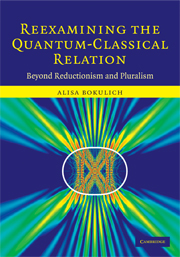Book contents
- Frontmatter
- Contents
- Acknowledgements
- Introduction
- 1 Intertheoretic relations: Are imperialism and isolationism our only options?
- 2 Heisenberg's closed theories and pluralistic realism
- 3 Dirac's open theories and the reciprocal correspondence principle
- 4 Bohr's generalization of classical mechanics
- 5 Semiclassical mechanics: Putting quantum flesh on classical bones
- 6 Can classical structures explain quantum phenomena?
- 7 A structural approach to intertheoretic relations
- References
- Index
5 - Semiclassical mechanics: Putting quantum flesh on classical bones
Published online by Cambridge University Press: 04 August 2010
- Frontmatter
- Contents
- Acknowledgements
- Introduction
- 1 Intertheoretic relations: Are imperialism and isolationism our only options?
- 2 Heisenberg's closed theories and pluralistic realism
- 3 Dirac's open theories and the reciprocal correspondence principle
- 4 Bohr's generalization of classical mechanics
- 5 Semiclassical mechanics: Putting quantum flesh on classical bones
- 6 Can classical structures explain quantum phenomena?
- 7 A structural approach to intertheoretic relations
- References
- Index
Summary
Though this be madness, yet there is method in't.
Shakespeare, Hamlet, Act 2 Scene 2Introduction
Semiclassical mechanics can be broadly understood as the theoretical and experimental study of the interconnections between classical and quantum mechanics. More narrowly, it is a field that uses classical quantities to investigate, calculate, and even explain quantum phenomena. Its methods involve an unorthodox blending of quantum and classical ideas, such as a classical trajectory with an associated quantum phase. For these reasons, semiclassical mechanics is often referred to as “putting quantum flesh on classical bones,” where classical mechanics provides the skeletal framework on which quantum quantities are constructed.
There are three primary motivations for semiclassical mechanics: First, in many systems of physical interest, a full quantum calculation is cumbersome or even unfeasible. Second, even when a full quantum calculation is within reach, semiclassical methods can often provide intuitive physical insight into a problem, when the quantum solutions are opaque. And, third, semiclassical investigations can lead to the discovery of new physical phenomena that have been overlooked by fully quantum-mechanical approaches. Semiclassical methods are ideally suited for studying physics in the so-called mesoscopic regime, which can roughly be understood as the domain between the classically described macro-world and the quantum mechanically described micro-world. An area in which semiclassical studies have proven to be particularly fruitful is in the subfield of quantum chaos.
- Type
- Chapter
- Information
- Reexamining the Quantum-Classical RelationBeyond Reductionism and Pluralism, pp. 104 - 134Publisher: Cambridge University PressPrint publication year: 2008



